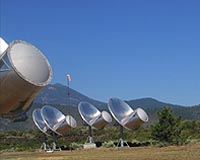Simple English wikipedia
April 20th, 2009 at 3:17 pm (Education, Writing)
An xkcd comic led me to the Simple English Wikipedia. This wikipedia aims to provide simplified versions of articles from the Ordinary English Wikipedia by limiting the vocabulary used, grammar complexity, and sentence length. I admire the motivation behind this resource: to make general knowledge accessible to non-native speakers, youthful readers, or those with disabilities. Yet to an adult native English speaker, the language of these articles can be gratingly unaesthetic (and imprecise). For example, consider this excerpt from the page on Mars:
The planet Mars is made of rock. The ground there is red because of iron oxide (rust) in the rocks and dust. The planet has a small carbon dioxide atmosphere. The temperatures on Mars are colder than on Earth, because it is farther away from the Sun. There is some ice at the north and south poles of Mars, and also frozen carbon dioxide.
This is all factually accurate, but achingly simplistic (especially the “because it is farther away from the Sun” statement — the atmospheric composition is also a critical player). On the other hand, if I had to read wikipedia in, say, French, I would no doubt appreciate the simplicity!
But I experienced even more wincing when reading pages about topics from Computer Science, such as the neural network page, half of which consists of:
What is important in the idea of neural networks is that they are able to learn by themselves, an ability which makes them remarkably distinctive in comparison to normal computers, which cannot do anything for which they are not programmed.
(Technically, they don’t learn by themselves — they require supervision in the form of labeled examples — and any machine learning method exhibits the learning property, not just neural networks, and what is a “normal computer” anyway? A neural network is an algorithm for learning a model, not a special-purpose computer. Finally, even neural networks cannot do anything for which they are not programmed! More accurate: “Neural networks can learn from examples, allowing them to make predictions about objects they may never have seen before (generalize).”)
Or consider this part of the page on Computer Science itself:
A computer is a device which takes orders as fast as you can give them to it and works as fast as it can to solve the orders.
(makes a computer sound like an active agent (e.g., waiter), which it isn’t) or from Computer programming:
The instructions in “machine form” are usually in a .EXE file (which is called an executable, because it can be executed). These machine-instructions will by default open a black “command-prompt” window, but can open games as well as other things.
(Well, am I really surprised that “simple” computer programming has such a strong Windows bias? ;) )
There’s an interesting issue at the heart of this project: how do you talk simply without talking down? (Or worse, misleading the reader!) Clear, simple language has real value even outside of this venue. However, translating all value judgments into the simple words “good” or “bad” not only gives the text a childlike sound but also gives its meaning a childlike interpretation, and important distinctions may be lost.
I actually find this wikipedia harder to read, not easier; the stilted sequences of simple sentences dominate my attention with their awkward rhythms and unanticipated gaps (likewise, you may have found my alliteration distracting :) ). Good writing blends its details in to the background and leaves you room to think about the ideas being presented. But yes, I know: I’m not the target audience for this product. I expect that many people are benefiting from much of the information in the Simple English Wikipedia. Hopefully they also get a chance to dig deeper for the real details on their subjects of most interest or need.



 But why move if you don’t have to? Engineers have developed a clever way to simulate a directional antenna from a collection of smaller, stationary, omnidirectional ones. Given multiple antennas in a line, if you shift the phase of each one progressively more, then combine the signals together, the result is the same as if you had rotated a single larger antenna to point to the side. If you have the ability to digitally change the phase shift for each antenna, then you can “point” your array anywhere you like without moving anything physically. This is called “digital beamforming.” (Technically, beamforming permits the manipulation of both the phase and the amplitude of each component antenna’s signal.) The
But why move if you don’t have to? Engineers have developed a clever way to simulate a directional antenna from a collection of smaller, stationary, omnidirectional ones. Given multiple antennas in a line, if you shift the phase of each one progressively more, then combine the signals together, the result is the same as if you had rotated a single larger antenna to point to the side. If you have the ability to digitally change the phase shift for each antenna, then you can “point” your array anywhere you like without moving anything physically. This is called “digital beamforming.” (Technically, beamforming permits the manipulation of both the phase and the amplitude of each component antenna’s signal.) The